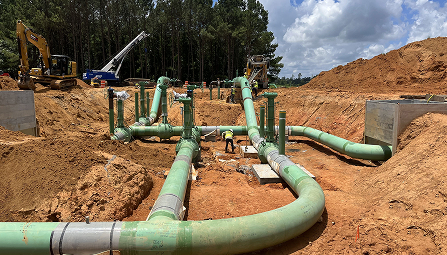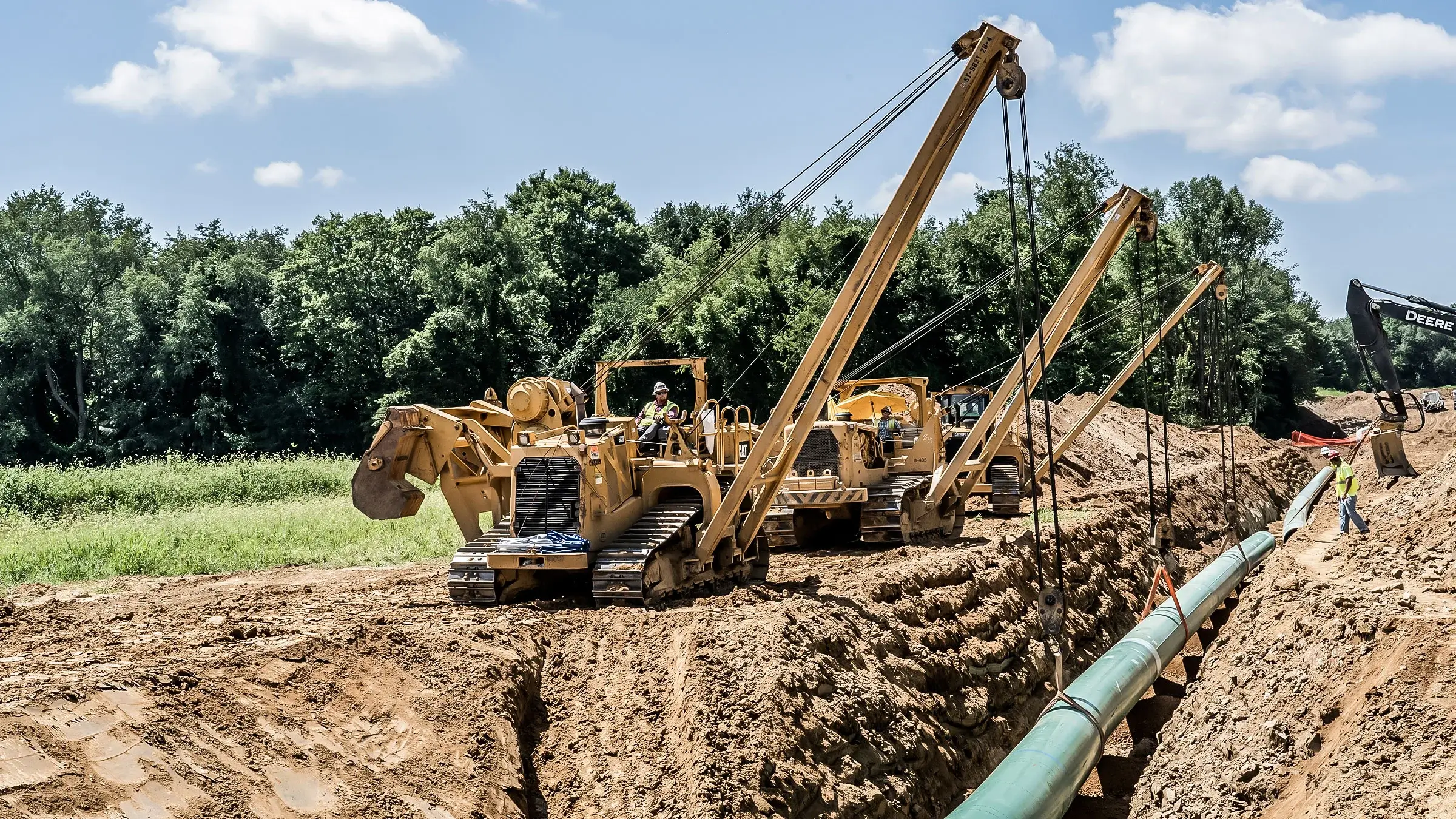Discovering the current Technologies in Pipeline Construction Providers for Modern Projects
The Pipeline Construction market is going through considerable changes. Developments such as smart products and robotics are improving conventional methods. These improvements promise to boost performance and safety. In addition, AI innovations are enhancing job management abilities. As these components merge, they question regarding their long-lasting effect on sustainability and cost. Comprehending these innovations is crucial for stakeholders wanting to navigate this evolving landscape. What implications do they hold for future tasks?
The Increase of Smart Products in Pipeline Construction
As the need for much more sustainable and efficient Pipeline systems increases, the assimilation of wise products has actually become a transformative option in Pipeline Construction. These sophisticated products possess distinct homes that boost the efficiency and longevity of pipes. For example, self-healing polymers can instantly fix small leaks, significantly lowering upkeep costs and downtime. Additionally, materials installed with sensors can check architectural stability and environmental conditions, enabling for real-time data collection and analysis.
Moreover, wise materials are typically lightweight and corrosion-resistant, which not just streamlines setup yet also extends the life expectancy of the systems. Their versatility allows pipes to endure severe ecological problems, promoting security and dependability. As markets increasingly prioritize sustainability, making use of environmentally friendly wise materials adds to lowered environmental impact. Overall, the surge of smart products marks a noteworthy change in Pipeline Construction, leading the method for innovative remedies to meet modern infrastructure demands.
Advancements in Robotics for Installation and Maintenance
The combination of clever products in Pipeline Construction is complemented by improvements in robotics, which are reinventing installation and maintenance processes. Robotic technologies, such as automated welding systems and drones, improve efficiency and accuracy, minimizing human mistake and decreasing safety risks. These robots can run in tough environments, guaranteeing that setups are conducted in harmful or remote locations without putting employees at threat.
Moreover, robotic examination tools outfitted with innovative sensing units offer real-time data on Pipeline honesty, enabling aggressive maintenance. They can detect leakages or architectural weak points, allowing prompt treatments that expand the lifespan of Pipeline systems. Making use of robotics not only increases the Construction timeline but likewise optimizes resource allotment, leading to set you back financial savings. As these innovations continue to evolve, they are set to play a crucial duty in shaping the future of Pipeline Construction, making certain dependability and sustainability in infrastructure development.
AI-Driven Job Monitoring Devices Transforming Operations
AI-driven project administration tools are reshaping operations in Pipeline Construction by enhancing decision-making processes with enhanced accessibility to real-time information analytics. These tools allow groups to respond swiftly to task developments, thereby enhancing performance. Structured interaction networks foster cooperation among stakeholders, better maximizing job end results.
Enhanced Decision-Making Procedures

Real-Time Data Analytics
Harnessing real-time information analytics, contemporary project monitoring tools transform operations in Pipeline Construction. These sophisticated tools take advantage of expert system to supply immediate understandings right into task efficiency, resource allotment, and potential risks. By continually keeping track of crucial efficiency indications, teams can quickly adjust to transforming conditions, maximizing labor and materials usage. The assimilation of real-time information enables even more educated decision-making, reducing hold-ups and reducing prices. Furthermore, anticipating analytics can recognize trends and forecast obstacles prior to they escalate, enhancing general job efficiency. Because of this, Pipeline Construction business that embrace these AI-driven devices can enhance task timelines and end results, guaranteeing they continue to be affordable in an increasingly complex sector landscape. This advancement marks a considerable change towards data-centric management techniques.
Streamlined Interaction Channels
Reliable interaction is extremely important in Pipeline Construction, where many stakeholders must work together seamlessly to assure project success. The intro of AI-driven project management devices has reinvented communication channels within the sector. These devices promote real-time information sharing, permitting groups to access updates, share papers, and track development effectively. By automating regular jobs and giving a central system for interaction, these technologies eliminate misconceptions and minimize delays. Improved visibility into job timelines and resource allowance cultivates responsibility amongst staff member. Additionally, AI analytics can identify possible interaction spaces, ensuring positive problem-solving. Eventually, streamlined interaction networks not only improve operations however also raise overall task performance, enabling Pipeline Construction companies to fulfill modern-day needs effectively.
Improved Safety Procedures Via Technology Integration
The assimilation of modern technology in Pipeline Construction has actually led to boosted security procedures. Real-time surveillance systems, wearable safety gadgets, and automated danger analyses are now crucial elements in lessening dangers on task websites. These technologies not just improve employee safety and security but likewise improve conformity with sector laws.
Real-Time Tracking Systems
How can real-time monitoring systems change Pipeline Construction security methods? By integrating innovative modern technology, these systems provide continuous monitoring of Construction tasks, ensuring immediate detection of potential hazards. Electronic cameras and sensing units can keep an eye on ecological problems, tools efficiency, and labor force motions, supplying crucial information in genuine time. This proactive approach permits job supervisors to recognize threats prior to they intensify, greatly enhancing security steps on-site. Furthermore, real-time surveillance promotes compliance with regulative needs, making certain that safety and security standards are met regularly. The capacity to evaluate information instantaneously sustains informed decision-making, enabling prompt treatments. As a result, Pipeline Construction tasks can operate more successfully while protecting the well-being of employees and minimizing accidents, thereby reinventing the sector's safety and security landscape.
Wearable Safety Tools
Frequently, wearable safety and security devices are being integrated right into Pipeline Construction to improve safety visit their website and security methods. These cutting-edge tools, consisting of wise safety helmets, vests, and wristbands, are developed to keep track of worker wellness and ecological problems in real-time. Equipped with sensing units, these gadgets can discover hazards such as toxic gas exposure, excessive warm, or high sound levels, offering instant signals to supervisors and employees. Additionally, wearable modern technology usually consists of general practitioner monitoring features, permitting effective location surveillance of workers on-site. This ability not just aids in quick response throughout emergency situations however additionally improves general job management. By prioritizing worker security via modern technology integration, Pipeline Construction companies are making significant strides in lowering mishaps and promoting a culture of safety within the market.

Automated Risk Evaluations
While standard threat assessments frequently count on manual evaluations, the integration of automatic danger assessment technologies is transforming safety procedures in Pipeline Construction. These innovative systems utilize information analytics, expert system, and artificial intelligence to identify possible dangers more precisely and efficiently. By constantly keeping an eye on ecological problems, devices standing, and employee habits, automated analyses give real-time insights that improve decision-making. This aggressive technique minimizes the likelihood of accidents and boosts conformity with security guidelines. Furthermore, automated danger analyses can be updated quickly, guaranteeing that all stakeholders have accessibility to the most recent information. Therefore, Pipeline Construction projects gain from a safer workplace, minimizing interruptions and cultivating a culture of safety and security with technology integration.
Lasting Practices in Pipeline Construction
As the need for energy framework increases, the Pipeline Construction market progressively focuses on lasting practices that decrease environmental influence. Companies are adopting environment-friendly materials and sophisticated Construction techniques to minimize their carbon impact. The use of trenchless technology enables for Pipeline setup with very little disturbance to the surrounding atmosphere, maintaining all-natural habitats and decreasing dirt erosion.
Maintaining Furthermore, the execution of eco-friendly power sources, such as solar or wind, to power Construction tasks is getting grip. This shift not only lowers dependence on nonrenewable fuel sources however likewise improves the Click This Link total sustainability of Pipeline projects. Moreover, efficient waste administration practices, consisting of recycling and reusing products, are becoming criterion in the market.
Real-Time Monitoring and Anticipating Maintenance Solutions
The shift towards sustainable methods in Pipeline Construction has actually led the method for the integration of real-time monitoring and anticipating maintenance services. These modern technologies leverage progressed sensing units and data analytics to continuously analyze Pipeline integrity and operational performance. By gathering data in real time, operators can discover abnormalities such as leakages or stress declines before they rise into major concerns. This positive method not just reduces ecological threats but likewise decreases downtime and maintenance prices.
Anticipating maintenance uses formulas to anticipate potential failures based upon historic data and present efficiency metrics. This makes it possible for prompt treatments, optimizing maintenance schedules and resource allotment. Overall, real-time surveillance and anticipating upkeep remedies represent a significant innovation in Pipeline Construction, boosting safety and security and integrity while sustaining sustainability objectives. As sectors continue to welcome these advancements, the functional landscape of Pipeline monitoring is established to advance considerably, guaranteeing lasting viability and efficiency.
The Role of Drones in Surveying and Evaluation
Drones have become transformative devices in the evaluating and assessment of pipelines, using boosted effectiveness and accuracy. Their ability to capture high-resolution pictures and videos from numerous angles allows for thorough evaluations of Pipeline integrity without taking the chance of human safety. Equipped with innovative sensing units and thermal imaging capabilities, drones can identify leaks, rust, and architectural abnormalities that may not show up to the check my source nude eye.
In addition, the deployment of drones significantly reduces assessment time, enabling quicker decision-making for repair and maintenance. This efficiency equates to set you back savings and very little disturbance to bordering atmospheres. Drones can likewise access hard-to-reach areas, such as elevated structures or sturdy surfaces, additionally increasing the scope of inspections.
As the Pipeline industry proceeds to accept technical advancements, the integration of drones into checking and examination procedures is expected to expand, setting brand-new standards for functional excellence and safety and security in Pipeline Construction services.
Often Asked Questions
What Are the Prices Connected With Modern Pipeline Construction Innovations?
The expenses related to modern Pipeline Construction advancements often include innovative products, specialized labor, and cutting-edge modern technology. These variables add to higher preliminary financial investment, however can cause long-lasting cost savings through enhanced efficiency and minimized upkeep needs.
Just How Do Governing Adjustments Impact Pipeline Construction Technologies?
Regulative adjustments considerably influence Pipeline Construction innovations by necessitating the fostering of safer, a lot more effective techniques. Conformity requirements commonly drive advancement, causing advancements in materials, layout, and Construction techniques that enhance total task sustainability and safety and security.
What Skills Are Needed for Professions in Advanced Pipeline Construction?

Professions in sophisticated Pipeline Construction need expertise in engineering principles, task management, security procedures, and ecological laws. In addition, skills in modern technology integration, teamwork, and problem-solving are essential for traversing the complexities of modern-day framework projects.
Just How Can Firms Guarantee Compliance With Environmental Standards?
To guarantee conformity with ecological requirements, companies must implement rigorous training programs, carry out normal audits, and adopt best methods in sustainability. Engaging with stakeholders and checking regulative changes better reinforces their commitment to ecological stewardship.

What Are the Trick Obstacles Encountering Pipeline Construction Today?
The crucial challenges encountering Pipeline Construction today include regulatory conformity, environmental issues, varying material expenses, labor shortages, and the need for sophisticated technology assimilation (Pipeline Construction Services). These aspects complicate job timelines and general effectiveness in the market
As the demand for extra lasting and reliable Pipeline systems boosts, the assimilation of smart materials has emerged as a transformative option in Pipeline Construction. AI-driven job management tools are improving workflows in Pipeline Construction by improving decision-making processes via enhanced access to real-time information analytics. While project administration in Pipeline Construction has traditionally relied on manual processes, the combination of innovative tools substantially enhances decision-making abilities. Using real-time data analytics, modern-day project administration devices revolutionize operations in Pipeline Construction. Careers in sophisticated Pipeline Construction need knowledge in engineering concepts, task management, safety and security procedures, and environmental guidelines.